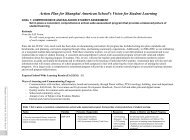Curriculum and Instruction - SAS-WASC
Curriculum and Instruction - SAS-WASC
Curriculum and Instruction - SAS-WASC
You also want an ePaper? Increase the reach of your titles
YUMPU automatically turns print PDFs into web optimized ePapers that Google loves.
from the United States, including Colorado, California <strong>and</strong> New York as well asthe National Science St<strong>and</strong>ards. The current <strong>SAS</strong> st<strong>and</strong>ards <strong>and</strong> benchmarks are acombination of the above. The recommendation from that group who reviewed thest<strong>and</strong>ards <strong>and</strong> benchmarks was to revisit the scope <strong>and</strong> sequence in high school toidentify redundancy <strong>and</strong> overlap of content. The 6-12 science task force work beganwith this recommendation in 2007-2008. Members mapped all science subjectsgrades six through twelve. Redundancies <strong>and</strong> gaps were identified <strong>and</strong> reports ofthe findings for each science subject are of file in the Science Subject Area EvidenceBinder.As lead-in to the work of mapping, in 2006-2007, discussions of inquiry-based learning<strong>and</strong> its relative importance to content learning in high school science education wereundertaken by a science action research team. They conducted a review of literature toreview on topics surrounding science education grades 6-12 <strong>and</strong> reviewed the currentofferings in science for high school, including grades nine <strong>and</strong> ten.In both grades nine <strong>and</strong> ten, students study a trimester each of biology, chemistry <strong>and</strong>physics. The science disciplines are taught separately, <strong>and</strong> at the Puxi campus, bydifferent teachers. Students might take physics first, then biology <strong>and</strong> chemistry – thetrimesters are designed to be taken in any order. This led to some discussion about thereadiness of grade nine students, in terms of their mathematics skills, to begin withphysics.Puxi campus offered data (as Pudong high school had not yet had a senior class –incomplete grade data <strong>and</strong> no testing data existed) <strong>and</strong> an analysis of quantitativedata as regards the current grade 9-10 program (e.g., Puxi data on grades, sciencecoursework taken). The action research team followed a data dialog protocol on thequantitative data. The conclusion of the group was that the program as it st<strong>and</strong>s isresulting in high grades <strong>and</strong> good scores on IB external examinations (for data, seeScience Subject Area Evidence Binder)In 2007-2008, the work began with mapping, an exercise that engendered discussionsof the difficulty of covering all the st<strong>and</strong>ards <strong>and</strong> benchmarks in all grades. Theconversations hearkened back to the 2005-2006 review, which saw the adding onof skills-based st<strong>and</strong>ards to st<strong>and</strong>ards that, in the past, had been primarily contentbased.Though all benchmarks are covered, a balance of skills <strong>and</strong> content withina manageable time frame is difficult to accomplish with the benchmarks <strong>and</strong> draftessential teaching agreements as they now st<strong>and</strong>. The argument is that the schedule,grading periods, <strong>and</strong> the curriculum don’t always give opportunities for teachers tocover them in the depth that is needed to do meaningful assessment. Much of thebest practice literature points to greater need for skills <strong>and</strong> less emphasis on content– but the data that Puxi high school provided the action research team in 2006-2007,suggests that the content benchmarks are sufficient for students to do well on externalassessments like IB <strong>and</strong> AP. The question remains: how do science teachers maintainhigh results on critical external exams <strong>and</strong> balance content with skills as best practicedem<strong>and</strong>s. It may be useful to forge stronger links between content <strong>and</strong> conceptthemes, which would also help students apply skills <strong>and</strong> connect their learning. Theschool would benefit from outside expertise in searching for resolution to the content/skills debate <strong>and</strong> how best to address the balance.AtlasAt the time of the task force’s curriculum mapping for science, there were not enoughunits posted to construct accurate maps. As progress is made in this area, it shouldbecome increasingly possible to see what is actually taught in science classrooms –<strong>and</strong> that may shed light on solutions to the content/skills debate.Shanghai American School Self Study Report 103



